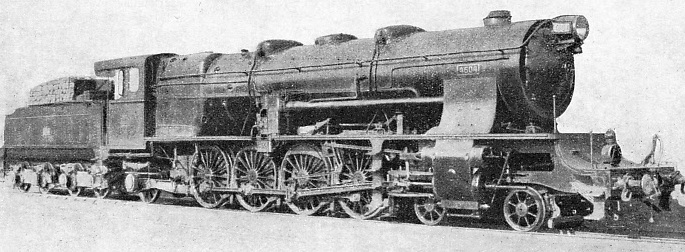
© Railway Wonders of the World 2012-


Part 46


Part 46 of Railway Wonders of the World was published on Friday 13th December 1935.
This issue contained a black and white art plate showing locomotive cab fittings. The plate was attached to page 1453, or the fifth page of this number.
The Cover
The cover this week depicts the Southern Railway locomotive “Lord Hawke” at Walton-on-Thames Station, Surrey. The engine is of the famous “Lord Nelson” class.
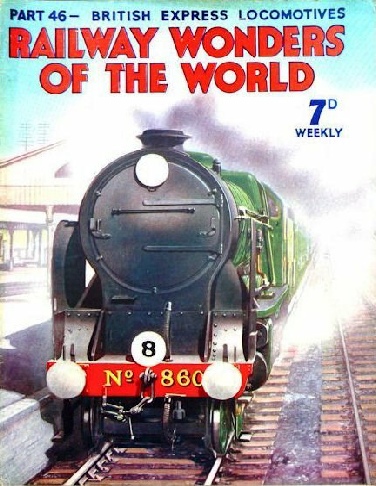
Chicago’s Unique Underground
The story of the Chicago freight tunnels, concluded from part 45.
(Pages 1445-1447 )
Contents of Part 46
Chicago’s Unique Underground (Part 2)
Locomotive Accessories
Locomotive Cab Fittings (art plate)
In Central Europe
British Express Locomotives
Spain and Portugal (Part 1)
In Central Europe
Many important new railway systems came into existence after the war of 1914-1918. Two of the most important are those of Czechoslovakia and Yugoslavia. The major portion of the Czechoslovak railways was formerly under the control of the State Railways of the Austro-Hungarian Empire. Since the war the policy of the Czechoslovak railways has been to improve main lines, and to afford better international communications. Electrification has also been carried out, and more is planned. The Czechoslovakia State lines conveyed some 220,000,000 passengers in 1933. The State Railways of Yugoslavia have overcome many difficulties, some of them unconnected with the railways themselves. The railways of Yugoslavia are also described in this chapter.
(Pages 1454-1463 )
British Express Locomotives
The year 1935 has been one of the most eventful years in the history of railways. There have been developments vital to the future of rail transport. On March 5 the LNER steam locomotive “Papyrus” attained a speed of 108 miles and hour; later, a streamlined engine in Germany touched a speed of 119 miles an hour; then came a host of startling time-table accelerations in the USA. In Europe there has also been a reduction of schedules, and an increase of super-speed rail-cars. In Great Britain the large number of runs at over sixty miles an hour was greatly augmented. The new LMS turbine-driven express locomotive marked a significant advance; finally there was the record-breaking streamlined train “Silver Jubilee”, which was described in part 45. The rapid progress has been due to the steady improvement in the tractive effort of the modern locomotives - especially in Great Britain. This chapter includes a thorough survey of the notable classes of each of the four big systems and will contain a comprehensive table showing the chief dimension of the principal classes of British express engines in use to-day.
(Pages 1464-1472 )
Spain and Portugal (Part 1)
The systems of one of the older European countries, Spain, are representative of modern influence upon that ancient nation. Some misinformed people believe that Span has not advanced with the times. But this chapter disproves this statement. A nation’s railways are a guide to a nation’s progress or decline. This chapter shows that an excellent service is offered to-day by the various companies. In countries as mountainous as Spain and Portugal narrow-gauge lines might be expected, but the main gauge is, on the contrary, very broad - 5 ft 6 in - and only to be found elsewhere in India and the Argentine. The main routes through Spain are particularly interesting. The railways in that country began in 1848. By the end of the nineteenth century, the mileage of track open totalled some 8,000. To-day it is over 10,000. One of the chief Spanish railways is the Northern, which owns some 2,300 miles of broad-gauge track, besides a large mileage of metre-gauge track. This company operates the most important trunk line from Madrid to Irun on the French frontier. Further, the Northern has followed a policy of electrification, and some of its most difficult sections are worked by electrically-hauled trains. There are no through expresses between Paris and Madrid, because of the break of gauge. One of the busiest links between France and Spain, however, is Irun, which connects with Hendaye on the system of the Paris-Orleans-Midi system.
The total railway mileage in Portugal is about 2,130, and of this total over 1,500 are controlled by the Portuguese Railways Company, and the remainder by smaller companies. The gauge of the Portuguese railways is the same as that of the Spanish, 5 ft 6 in. This system too is included in this interesting chapter. The article is concluded in part 47.
(Pages 1473-1476 )
Locomotive Accessories
This chapter describes one of the most important items of a railway engine’s equipment - the injector, which supplies water to the boiler. Invented in 1859 by Frenchman, Henri Giffard, it now forms a vital part of the modern engine. The action and use of the donkey-pump, the feed-water heater , the soot-blower , the steam-blower , and the ”booster” will also be clearly explained. The “booster” is one of the most interesting locomotive accessories. It is a small auxiliary engine which drives one or more pairs of wheels on the engine or tender. The “booster” is employed chiefly to give extra power when starting exceptionally heavy trains, and has been installed on several big American and on some British locomotives. This is the seventeenth and final article in the series on Design and Invention.
You can read a useful technical summary of the steam locomotive injector in George Nissenson’s treatise (1890).
(Pages 1448-1453 )
A Combined Pump and Heater
A COMBINED PUMP AND HEATER for the boiler feed water fitted by Messrs. J. Stone, Ltd., To a “Beyer-Garratt” locomotive on the Kenya-Uganda Railway. The water is heated by means of tubular heaters which are placed on top of the boiler. The pump, with its valves, is situated at the side of the boiler, and is controlled from the locomotive cab. To the left of the feed-water heater pump is shown a small steam turbine and electric generator for supplying current to the headlights at either end of the engine. To the left of the feed-water heater is seen the dome from which steam is taken to the cylinders, and to the left of this again are the clack valves through which water is supplied to the boiler. Against the smoke-box can be seen the Westinghouse pump for supplying compressed air to the brake system.
(Page 1451)
Locomotive Cab Fittings
The cab fittings of a modern express engine. The numbers on the illustration are explained in the key beneath the photograph.
The cab illustrated is of a “King” class locomotive, and so this photograph complements
the frontispiece.
(Between pages 1452-1453 )
Czechoslovakian Locomotives - 1
(Top) TWO-CYLINDER SUPERHEATED GOODS LOCOMOTIVE in operation of the State lines of Czechoslovakia. Built to work on standard gauge track, this 2-10-0 engine has cylinders 24 in by 25 in, and driving wheels of 4 ft 3 in. The total heating surface, including superheater, is 3,638 sq ft. The working pressure is 205 lb per sq in. The locomotive is fitted with a Westinghouse brake and has a special sprinkling device for coal.
(Middle) 4-6-2 TANK LOCOMOTIVE in service in Czechoslovakia. The cylinders measure 18 in by 28 in, and the coupled wheels have a diameter of 5 ft 3 in. Total heating surface of the locomotive, including superheater, is 1,171 sq ft, and the area of the fire-grate is 21½ sq ft. The speed indicator is of the “Haushaelter-Reszny” type, with automatic recording. It is fitted to the right side of the cab wall and worked from the rear coupling rod.
(Bottom) 2-10-2 SUPERHEATED TANK. This Czechoslovak locomotive has five coupled axles, of which the centre one is the driving axle. The cylinders measure 24 in by 22 in, and the coupled wheels have a diameter of 4 ft 1 in. The total heating surface amounts to 2,162 sq ft and the boiler pressure is 191 lb per sq in.
(Page 1462)
“Radley” - a “Schools” Class Engine
“RADLEY”, a “Schools” class engine of the Southern Railway, at the head of a Portsmouth and Isle of Wight express at Waterloo Station. The well-known “Schools” class locomotives work all the principal Waterloo-Portsmouth trains. The best expresses cover the 74½ miles between Waterloo and Portsmouth in just over 1½ hours.
(Page 1464)
“Princess Margaret Rose”
“Princess Margaret Rose”, a 4-6-2 express locomotive built for the LMS in 1935. The engine has four single expansion cylinders measuring 16¼ in by 28 in, and the driving wheels have a diameter of 6 ft 6 in. The boiler pressure is 250 lb per sq in, and the total hearing surface, including superheater, is 2,967 sq ft. The grate area is 45 sq ft, and the engine alone in working order weighs 104 tons 10 cwt.
(Page 1468)
“Papyrus”
“Papyrus”, a LNER “Pacific” 4-6-2 three-cylinder express engine at speed. This famous engine covered 536.6 miles at an average of over 70 miles an hour, and achieved a maximum of 108 miles an hour when of a test run between London and Newcastle and back in March 1935. Of the round trip, 300 miles were covered at an average speed of 80 miles an hour. The special train weighed 217 tons.
(Page 1472)
A 4-8-2 Locomotive on the Northern Railway of Spain
ON THE NORTHERN RAILWAY OF SPAIN. A 4-8-2 locomotive used for fast good and heavy passenger trains. The 4-8-2 type is popular in Spain, and many engines of this type in operation on the Northern railway were constructed in Germany. The Northern Railway of Spain has some 1,170 steam locomotives in operation.
(Page 1475)
Railways. This powerful engine has cylinders measuring 21½ in by 26 in, and the diameter of the driving wheels is 5 ft 10 in. The working pressure of the locomotive is 235 lb per sq in. The designed maximum speed is just under 70 miles and hour.
(Page 1463)
The Chicago Underground Freight System
600,000 TONS of package freight are handled every year by the Chicago underground freight system. Tracks for tunnel trains are laid also in railway warehouses, and tunnel trucks are conveyed up from below by elevators. This helps to reduce congestion in the streets of the city.
(Page 1447)
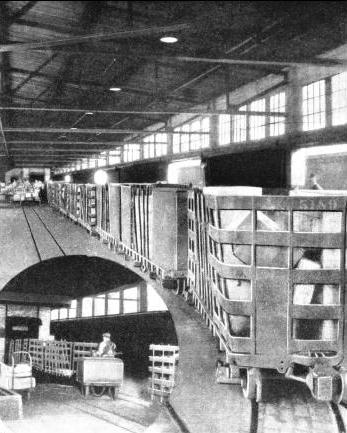
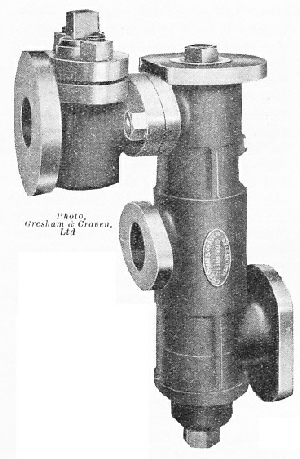
A Modern Injector
A MODERN INJECTOR is shown in this illustration, and the compact design of this important auxiliary to a locomotive is clearly indicated. Steam is taken to the top of the long casting at the right. On the left of the steam inlet is the cock controlling the water supply. Beneath the water cock is the flange to which is bolted the overflow pipe. The flange at the bottom of the main casting, on the right, is bolted to a pipe delivering feed water to the boiler.
(Page 1449)
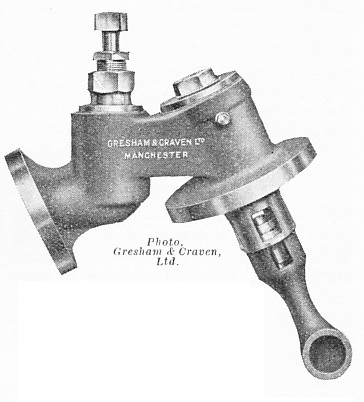
A Feed Water Heater
FEED WATER is heated by means of this apparatus (shown left), which is bolted in duplicate to the top of a locomotive boiler shell. The flange on the left is bolted to the water supply pipe from the injector or pump. On top of the fitting can be seen the adjusting screw which controls the lift of the clack valve. The right-hand flange is bolted to the boiler barrel, and immediately beneath this can be seen the openings to the two cones . The feed water is delivered to the boiler through the out-turned opening shown.
(Page 1449)
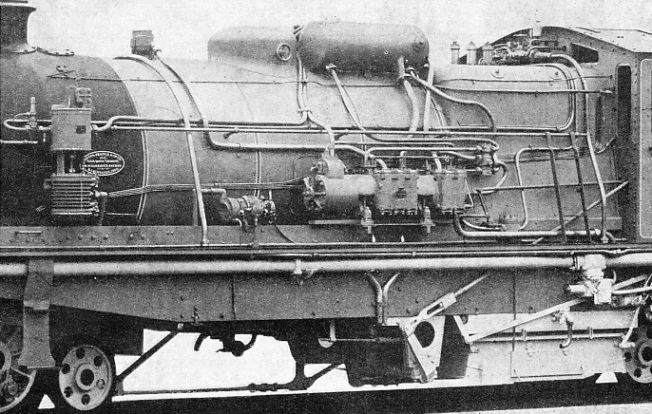
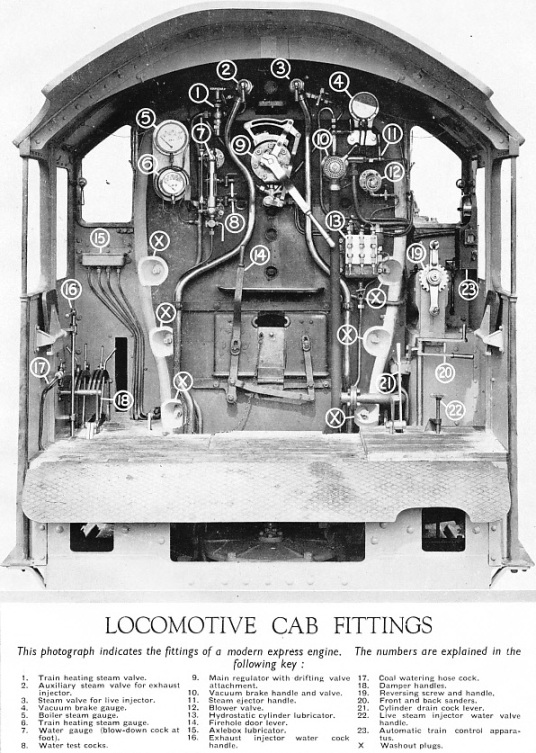
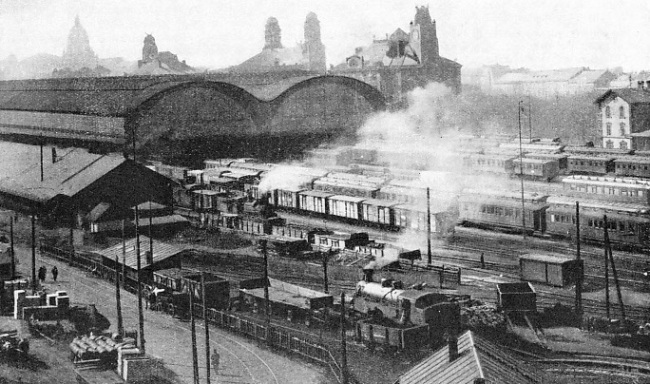
Wilson Station, Prague
WILSON STATION at Prague is the largest passenger station in Czechoslovakia. The above illustration, taken from behind the terminus, shows that part of the building which accommodates trains arriving from the east and north of Czechoslovakia.
(Page 1454)
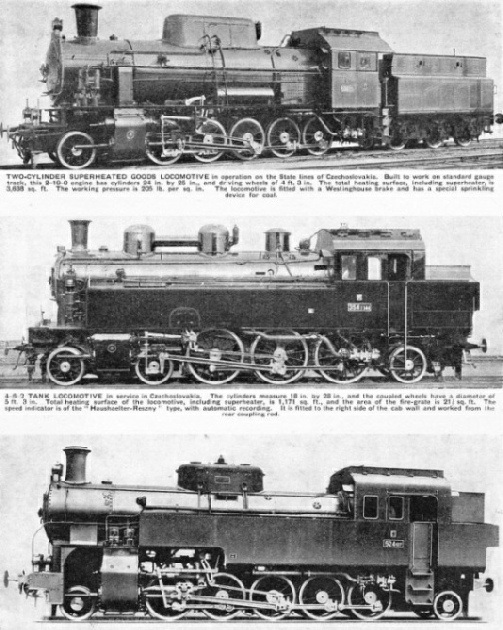
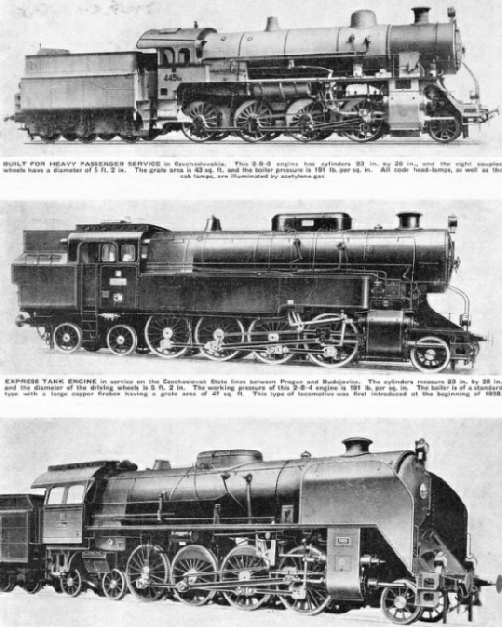
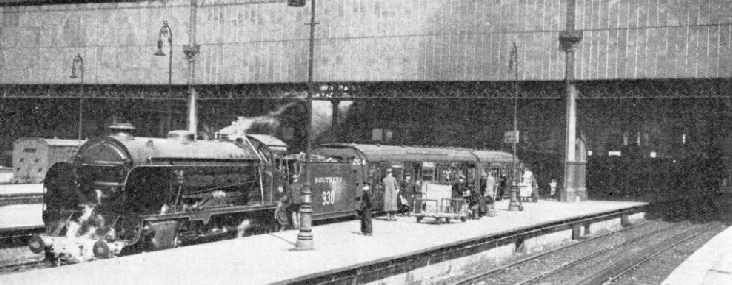
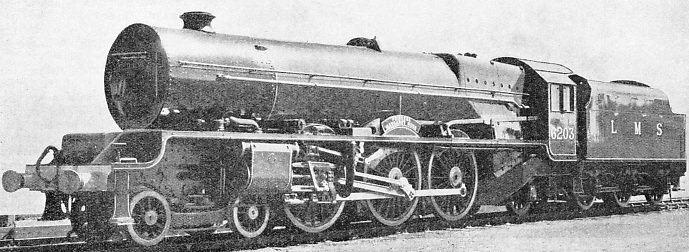
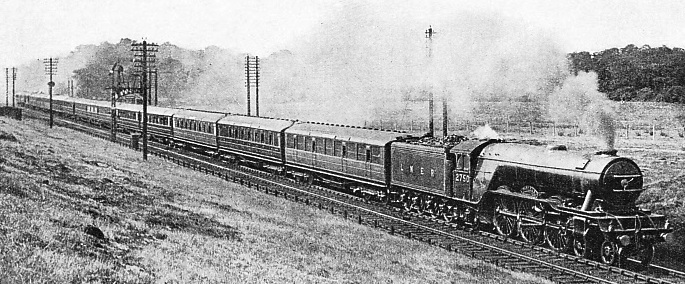
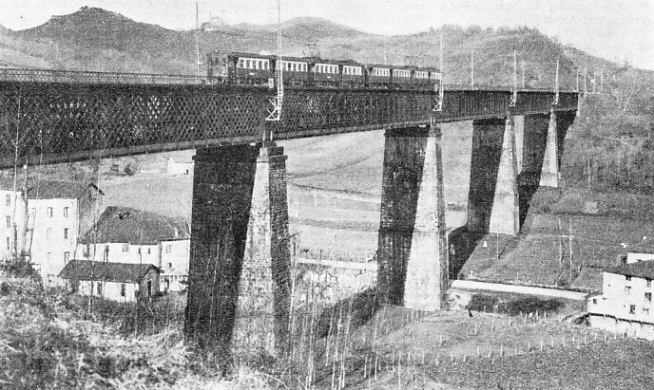
A Steel Bridge of Five Spans
A STEEL BRIDGE OF FIVE SPANS at Ormaiztegui, 357 miles north of Madrid, which carries a section of electrified track of the lines of the Northern railway of Spain. This railway, which was incorporated in 1858, has adopted a policy of electrification, and the Irun-Alsasua, Catalonian, and Pajares Incline sections have been electrified. The company owns some seventy electric locomotives.
(Page 1473)
